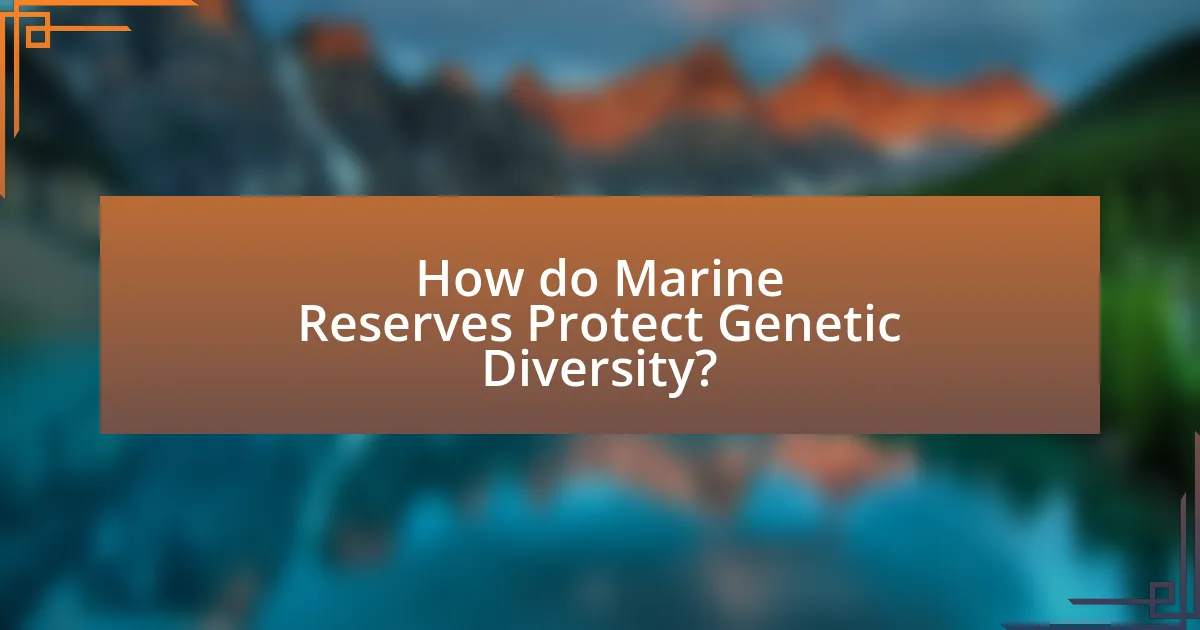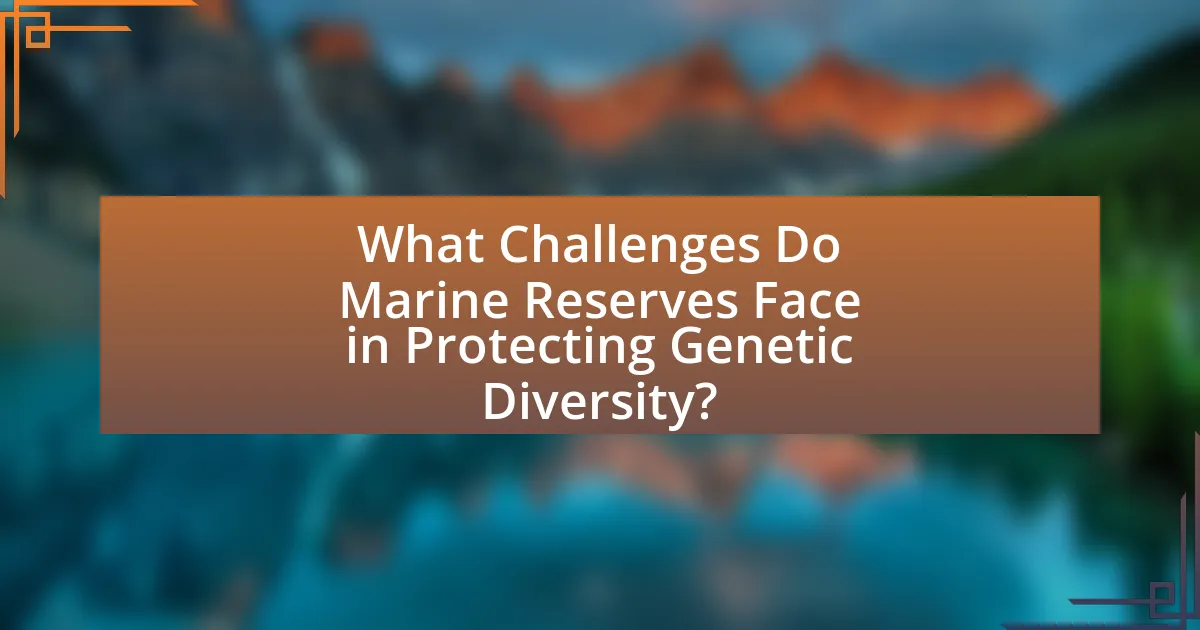Marine reserves are designated areas in oceans or seas where human activities are restricted to protect marine ecosystems and enhance biodiversity. This article examines the critical role of marine reserves in conserving genetic diversity, highlighting their effectiveness in increasing fish populations, maintaining ecosystem resilience, and providing safe habitats for various marine species. It discusses the mechanisms through which marine reserves safeguard genetic diversity, the challenges they face, and the socio-economic implications for local communities. Additionally, the article outlines best practices for improving marine reserve management and emphasizes the importance of community involvement in conservation efforts.

What are Marine Reserves and Their Purpose?
Marine reserves are designated areas in oceans or seas where human activities, such as fishing and resource extraction, are restricted or prohibited to protect marine ecosystems. Their primary purpose is to conserve biodiversity, enhance fish populations, and maintain the health of marine habitats. Research indicates that marine reserves can lead to increased biomass and species diversity, as seen in studies conducted by the National Oceanic and Atmospheric Administration, which found that fully protected marine areas can yield fish populations that are up to three times larger than those in unprotected areas.
How do Marine Reserves contribute to biodiversity conservation?
Marine reserves contribute to biodiversity conservation by providing protected areas where ecosystems can thrive without human interference. These reserves help maintain and restore populations of various marine species, which is crucial for preserving genetic diversity. Research indicates that marine reserves can lead to increased biomass and species richness, as seen in studies such as the one conducted by Halpern et al. (2009), which found that marine protected areas can enhance fish populations by up to 200% compared to unprotected areas. This increase in population size and diversity supports ecosystem resilience and stability, ultimately benefiting overall biodiversity conservation efforts.
What specific roles do Marine Reserves play in protecting species?
Marine reserves play a crucial role in protecting species by providing safe habitats that promote biodiversity and allow for the recovery of overexploited populations. These protected areas limit human activities such as fishing and habitat destruction, which can lead to declines in species populations. Research indicates that marine reserves can increase fish biomass by up to 600% within their boundaries, thereby enhancing the resilience of marine ecosystems. Additionally, marine reserves serve as critical sites for research and monitoring, contributing to our understanding of species interactions and ecosystem health.
How do Marine Reserves enhance ecosystem resilience?
Marine reserves enhance ecosystem resilience by providing protected areas that allow marine species to thrive and recover from environmental stressors. These reserves facilitate the maintenance of biodiversity, which is crucial for ecosystem stability and adaptability. For instance, studies have shown that marine reserves can increase fish populations and biomass, leading to healthier ecosystems that can better withstand changes such as climate fluctuations and pollution. Additionally, the genetic diversity preserved within these reserves supports the resilience of species to diseases and environmental changes, as diverse genetic pools enable populations to adapt more effectively.
Why is genetic diversity important in marine ecosystems?
Genetic diversity is crucial in marine ecosystems because it enhances resilience to environmental changes and diseases. A diverse gene pool allows marine species to adapt to varying conditions, such as climate change and habitat loss. For instance, studies have shown that coral reefs with higher genetic diversity are more resilient to bleaching events, which can devastate less diverse populations. This adaptability is vital for maintaining ecosystem stability and function, as diverse species contribute to various ecological roles, ensuring the overall health of marine environments.
What are the benefits of genetic diversity for marine species?
Genetic diversity benefits marine species by enhancing their resilience to environmental changes and diseases. This diversity allows populations to adapt to varying conditions, such as climate change and habitat loss, thereby increasing their chances of survival. For instance, studies have shown that genetically diverse populations of coral reefs are more resilient to bleaching events, which are exacerbated by rising sea temperatures. Additionally, genetic diversity contributes to the overall health of ecosystems, as it supports a wider range of functions and interactions among species. This interconnectedness is crucial for maintaining the balance of marine environments, ultimately benefiting both marine species and human communities that rely on these ecosystems.
How does genetic diversity affect ecosystem stability?
Genetic diversity enhances ecosystem stability by increasing resilience to environmental changes and disturbances. Diverse genetic traits within a population allow species to adapt to varying conditions, such as climate shifts or disease outbreaks, thereby maintaining ecosystem functions. For instance, studies have shown that ecosystems with higher genetic diversity are better able to withstand stressors, as seen in coral reefs where genetic variation among coral species contributes to their ability to recover from bleaching events. This adaptability is crucial for sustaining biodiversity and ecosystem services, which are essential for human well-being.

How do Marine Reserves Protect Genetic Diversity?
Marine reserves protect genetic diversity by providing a safe habitat for various marine species, allowing populations to thrive without the pressures of fishing and habitat destruction. These protected areas enable species to reproduce and maintain healthy population sizes, which is crucial for preserving genetic variation. Research indicates that marine reserves can enhance genetic diversity by facilitating gene flow between populations, as seen in studies of coral reefs where reserves support higher genetic diversity compared to unprotected areas. This genetic diversity is essential for species resilience to environmental changes and diseases, ultimately contributing to the overall health of marine ecosystems.
What mechanisms do Marine Reserves use to safeguard genetic diversity?
Marine reserves safeguard genetic diversity primarily through habitat protection, which allows for the preservation of various species and their genetic variations. By restricting fishing and other human activities, marine reserves create safe environments where populations can thrive, reproduce, and maintain genetic diversity. Studies have shown that protected areas can enhance genetic diversity by providing stable habitats that support the survival of both common and rare species, thereby preventing genetic bottlenecks. For instance, research published in “Conservation Biology” indicates that marine reserves can increase genetic diversity in fish populations by up to 30% compared to unprotected areas, demonstrating their effectiveness in conserving genetic resources.
How do restrictions on fishing and habitat destruction support genetic diversity?
Restrictions on fishing and habitat destruction support genetic diversity by allowing marine populations to recover and maintain their genetic variability. When fishing is restricted, overexploitation is minimized, enabling fish populations to grow and reproduce, which enhances genetic mixing and resilience. Additionally, protecting habitats from destruction preserves the ecosystems that support diverse species, facilitating their adaptation to environmental changes. Studies have shown that marine reserves, which often include fishing restrictions, can increase genetic diversity by providing safe breeding grounds, as evidenced by research conducted in the Caribbean, where protected areas exhibited higher genetic diversity in coral reef fish compared to fished areas.
What role does habitat restoration play in enhancing genetic diversity?
Habitat restoration plays a crucial role in enhancing genetic diversity by re-establishing ecosystems that support a wider range of species and genetic variations. When habitats are restored, they provide the necessary conditions for populations to thrive, which can lead to increased gene flow among individuals. For example, studies have shown that restored habitats can facilitate the movement of species, allowing for interbreeding and reducing the risks of inbreeding depression. This is particularly important in marine environments, where habitat degradation can lead to isolated populations with limited genetic diversity. By improving habitat quality and connectivity, restoration efforts can enhance the resilience of species and ecosystems, ultimately contributing to greater genetic diversity.
What evidence supports the effectiveness of Marine Reserves in preserving genetic diversity?
Marine reserves effectively preserve genetic diversity, as evidenced by studies showing increased genetic variation in populations within these protected areas. Research conducted by Palumbi (2003) in the journal “Nature” demonstrated that marine reserves can enhance the genetic diversity of fish populations by providing a refuge from overfishing and habitat destruction. Additionally, a meta-analysis by Lester and Halpern (2008) in “Ecological Applications” found that marine reserves significantly increase the abundance and diversity of marine species, which correlates with higher genetic diversity. These findings indicate that marine reserves play a crucial role in maintaining and enhancing genetic diversity in marine ecosystems.
What studies demonstrate the impact of Marine Reserves on genetic diversity?
Studies demonstrate that marine reserves significantly enhance genetic diversity in marine populations. For instance, a study by Lester et al. (2009) published in “Ecology Letters” found that marine reserves can increase genetic diversity by providing a refuge for species, allowing for greater population stability and resilience. Another research conducted by Palumbi (2003) in “Science” highlighted that marine protected areas can facilitate gene flow among populations, thereby enhancing genetic diversity. Additionally, a meta-analysis by Micheli et al. (2012) in “Nature” confirmed that marine reserves contribute to increased genetic diversity across various species, supporting the notion that these protected areas are crucial for maintaining the genetic health of marine ecosystems.
How do Marine Reserves compare to non-protected areas in terms of genetic diversity?
Marine reserves exhibit significantly higher genetic diversity compared to non-protected areas. Research indicates that marine reserves provide a refuge for various species, allowing populations to thrive and maintain genetic variability. For instance, a study published in the journal “Conservation Biology” by Edgar et al. (2014) found that fish populations within marine reserves had up to 50% greater genetic diversity than those in adjacent non-protected areas. This enhanced genetic diversity is crucial for species resilience to environmental changes and diseases, ultimately supporting ecosystem stability.

What Challenges Do Marine Reserves Face in Protecting Genetic Diversity?
Marine reserves face significant challenges in protecting genetic diversity, primarily due to limited size and connectivity. Small reserves may not encompass the full range of habitats necessary for diverse species, leading to genetic bottlenecks. Additionally, isolation from other habitats restricts gene flow, which is crucial for maintaining genetic variability. Research indicates that fragmented habitats can reduce genetic diversity by up to 50% in certain marine species, as shown in studies on coral reef fish populations. Furthermore, human activities such as overfishing and pollution outside reserve boundaries can negatively impact the genetic health of populations within reserves, undermining their conservation efforts.
What external threats impact the effectiveness of Marine Reserves?
External threats that impact the effectiveness of Marine Reserves include climate change, overfishing, pollution, and habitat destruction. Climate change leads to ocean warming and acidification, which can disrupt marine ecosystems and reduce biodiversity. Overfishing outside reserve boundaries can deplete fish populations, undermining the reserves’ goals of replenishing stocks. Pollution from agricultural runoff and plastic waste can degrade water quality and harm marine life. Habitat destruction, such as coastal development and bottom trawling, can eliminate critical habitats that support diverse marine species. These factors collectively hinder the ability of Marine Reserves to protect genetic diversity effectively.
How do climate change and pollution affect Marine Reserves?
Climate change and pollution significantly threaten marine reserves by disrupting ecosystems and diminishing biodiversity. Rising ocean temperatures, a direct consequence of climate change, lead to coral bleaching, which adversely affects marine species that rely on coral reefs for habitat and food. Additionally, ocean acidification, another result of increased carbon dioxide levels, impairs the ability of marine organisms, such as shellfish, to form shells, further destabilizing marine ecosystems.
Pollution, particularly from plastics and agricultural runoff, introduces harmful chemicals and toxins into marine environments. These pollutants can lead to habitat degradation, reduced water quality, and increased mortality rates among marine species. For instance, nutrient runoff can cause algal blooms, which deplete oxygen levels in the water, creating dead zones where marine life cannot survive.
Research indicates that marine reserves, while designed to protect biodiversity, are not immune to these external pressures. A study published in “Nature” by Halpern et al. (2015) found that marine reserves are less effective in areas heavily impacted by climate change and pollution, highlighting the need for integrated management strategies that address these global challenges.
What are the socio-economic challenges associated with Marine Reserves?
Marine reserves face several socio-economic challenges, including the displacement of local fishing communities, loss of livelihoods, and conflicts over resource use. Displacement occurs when fishing areas are restricted, leading to economic hardship for those reliant on fishing for income. For instance, studies have shown that in regions where marine reserves are established, local fishers may experience a significant decline in catch, impacting their financial stability. Additionally, there can be conflicts between conservation goals and the economic interests of communities, as some stakeholders may prioritize immediate economic benefits over long-term ecological health. These challenges highlight the need for inclusive management strategies that consider both conservation and the socio-economic well-being of affected communities.
How can Marine Reserves be improved to better protect genetic diversity?
Marine reserves can be improved to better protect genetic diversity by implementing larger and more interconnected protected areas. Research indicates that larger reserves facilitate the movement of species and genetic exchange, which is crucial for maintaining genetic diversity. For instance, a study published in “Nature” by Edgar et al. (2014) found that marine reserves that are part of a network enhance biodiversity and genetic variability among populations. Additionally, incorporating adaptive management strategies that respond to environmental changes can further support genetic diversity by allowing for the protection of various habitats and species over time.
What best practices can be implemented in Marine Reserve management?
Effective Marine Reserve management can be enhanced by implementing best practices such as establishing clear objectives, conducting regular monitoring and assessment, engaging local communities, and enforcing regulations. Establishing clear objectives ensures that the goals of the reserve align with conservation efforts, such as protecting biodiversity and enhancing genetic diversity. Regular monitoring and assessment, supported by scientific research, allow for adaptive management based on the health of marine ecosystems, as evidenced by studies showing that reserves with ongoing assessments are more successful in achieving conservation goals. Engaging local communities fosters stewardship and compliance, as community involvement has been shown to improve the effectiveness of management strategies. Lastly, enforcing regulations is crucial; reserves with strict enforcement of fishing and habitat protection laws have demonstrated significant improvements in biodiversity and ecosystem health, as highlighted in the findings of the Marine Protected Areas Global Network.
How can community involvement enhance the effectiveness of Marine Reserves?
Community involvement enhances the effectiveness of Marine Reserves by fostering local stewardship and compliance with conservation measures. When communities actively participate in the management and monitoring of Marine Reserves, they develop a vested interest in the health of marine ecosystems, leading to increased adherence to regulations. Research indicates that areas with strong community engagement, such as the Caribbean’s Turneffe Atoll Marine Reserve, show improved biodiversity outcomes and better enforcement of protective measures. This local engagement not only aids in the protection of genetic diversity but also ensures that conservation strategies are culturally relevant and sustainable.
What practical steps can individuals take to support Marine Reserves and genetic diversity?
Individuals can support Marine Reserves and genetic diversity by participating in local conservation efforts, advocating for policy changes, and practicing sustainable behaviors. Engaging in beach clean-ups and habitat restoration projects directly contributes to the health of marine ecosystems. Advocating for policies that protect marine areas, such as supporting legislation for marine protected areas, helps ensure the preservation of biodiversity. Additionally, individuals can reduce their ecological footprint by choosing sustainable seafood, which supports fisheries that prioritize genetic diversity and ecosystem health. Research indicates that marine reserves can enhance genetic diversity by providing safe habitats for various species, thus reinforcing the importance of individual actions in conservation efforts.
